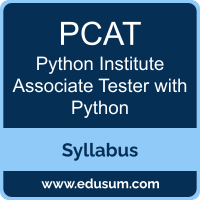 Use this quick start guide to collect all the information about Python Institute Associate Tester with Python (PCAT) Certification exam. This study guide provides a list of objectives and resources that will help you prepare for items on the PCAT Python Institute Certified Associate Tester with Python exam. The Sample Questions will help you identify the type and difficulty level of the questions and the Practice Exams will make you familiar with the format and environment of an exam. You should refer this guide carefully before attempting your actual Python Institute PCAT-31-0x certification exam.
Use this quick start guide to collect all the information about Python Institute Associate Tester with Python (PCAT) Certification exam. This study guide provides a list of objectives and resources that will help you prepare for items on the PCAT Python Institute Certified Associate Tester with Python exam. The Sample Questions will help you identify the type and difficulty level of the questions and the Practice Exams will make you familiar with the format and environment of an exam. You should refer this guide carefully before attempting your actual Python Institute PCAT-31-0x certification exam.
The Python Institute Associate Tester with Python certification is mainly targeted to those candidates who want to build their career in Testing domain. The Python Institute Certified Associate Tester with Python (PCAT) exam verifies that the candidate possesses the fundamental knowledge and proven skills in the area of Python Institute PCAT-31-0x.
Python Institute Associate Tester with Python Exam Summary:
| Exam Name | Python Institute Certified Associate Tester with Python (PCAT) |
| Exam Code | PCAT |
| Exam Price | $295 (USD) |
| Duration | 60 mins |
| Number of Questions | 42 |
| Passing Score | 70% |
| Books / Training | Python for Testing 101 (PT101) |
| Schedule Exam | OpenEDG Testing Service - TestNow |
| Sample Questions | Python Institute Associate Tester with Python Sample Questions |
| Practice Exam | Python Institute PCAT Certification Practice Exam |
Python Institute PCAT Exam Syllabus Topics:
| Topic | Details | Weights |
|---|---|---|
| Software Testing Essentials |
- Software Testing Concepts and Terminology
- Levels of Testing
- Software Testing Definitions
- Testing Principles
- Start and End of the Testing Process
- The Test Pyramid
- Code coverage
|
16.7% |
| Test Automation and Code Refactoring |
- The Goal and Importance of Test Automation
- The Code Refactoring Loop
- Code Refactoring
|
9.5% |
| Assertions, Context Managers, Decorators, and Methods |
- The Assertion Statement
- Context Managers
- Function Decorators
- Class Decorators
- Different Types of Python Methods
|
11.9% |
| Foundations of Unit Testing |
- Anatomy of a Unit Test
- xUnit Architecture
- Running Tests
- Good Practices
- Specialized Assertions
- Unit Tests as a Source of Documentation
- AAA Pattern Used in Practice
- Using the unittest Module
|
28.6% |
| Advanced Unit Testing Techniques |
- Unit Test Preparation
- Unit Test Parametrization
- Marking Tests for Special Conditions
- Selective Test Execution
- Using Test Doubles
- Mocking with Patch
- Handling Exceptions in Unit Tests
|
26.2% |
| Test-Driven and Behavior-Driven Development |
- Test-Driven Development Fundamentals
- Implementing the Red, Green, Refactor Phases
- Behavior-Driven Development Fundamentals
|
7.1% |
To ensure success in Python Institute PCAT-31-0x certification exam, we recommend authorized training course, practice test and hands-on experience to prepare for Python Institute Certified Associate Tester with Python (PCAT) exam.
